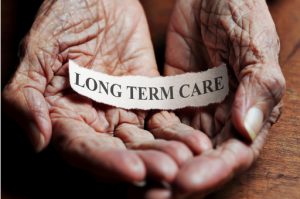
Long-term Care Insurance
 As we age we get more illnesses, develop limitations/disabilities, and a reduction in cognitive function. Although most of us will be self-sufficient a majority of the time, there will be times when we will require some assistance — whether it’s transportation, a home health aide, or long-term nursing home care.
As we age we get more illnesses, develop limitations/disabilities, and a reduction in cognitive function. Although most of us will be self-sufficient a majority of the time, there will be times when we will require some assistance — whether it’s transportation, a home health aide, or long-term nursing home care.
In 2023 the average annual cost of a private room in a skilled nursing facility or nursing home was $108,000; $94,896 for semi-private room. A home health aide costs an average of $61,776 per year. Long-term care insurance is a means of protecting yourself and your family from the financial devastation that can come from the need for these types of long-term assistance.
- Your illness may result in limitations/disabilities and/or a reduction in cognitive function that will require assistance such as transportation, help with personal care, or long-term nursing home care.
- Unlike traditional medical care that focuses on treating health problems, long-term care helps you with your daily life when your current health condition requires you to have assistance. This can include adult day care, help with daily living activities, home health care, hospice care, respite care, and/or assisted living facilities.
You may find better investment options to use if necessary for long-term care. This may include home equity, investments, or life insurance policies. This will result in long-term savings for most adults, however there is always a risk of the costs of long-term care exceeding what you have saved.
If you qualify, you could look for additional medical coverage that will cover long-term care costs. You can usually qualify for Medicaid if you have less than $2,000 of assets. See A state-by-state guide to Medicaid: Do I qualify for details of how to qualify for Medicaid.
Additional Details About Long-term Care Insurance
Although up to 70% of adults aged 65 years will need some form of professional care at home, it will usually be limited in scope and duration.
37% – 48% of adults will need a long-term care facility, which is more expensive, but most will only need it for a short time.
Up to 20% will need home or inpatient care for more than five years.
 Despite the need for long-term care, 63% of people will not have to pay out of pocket if they do not have long-term care insurance as many health insurance plans cover it. For example, Medicare covers temporary long-term hospital care. It will also cover the cost of some home health services, short-term nursing home stays, and hospice care for six months, but does not cover personal care or help with completing activities of daily living.
Despite the need for long-term care, 63% of people will not have to pay out of pocket if they do not have long-term care insurance as many health insurance plans cover it. For example, Medicare covers temporary long-term hospital care. It will also cover the cost of some home health services, short-term nursing home stays, and hospice care for six months, but does not cover personal care or help with completing activities of daily living.
Long-term care insurance policies will have a lifetime limit on long-term care services based on your health, preference, and the amount of premium you are willing or able to pay. In addition, most long-term care policies will limit coverage payments to a specific dollar amount for each day you spend in a nursing facility or for each home-care visit.
These policies will not pay for services for substance abuse addiction and alcoholism, treatment provided by government facilities, nervous and mental disorders (excluding dementia and Alzheimer’s), injuries and illness caused by acts of war, or injuries that are self-inflicted.
Although it is a difficult decision to make, there may be reasons why you would consider getting long-term care coverage if you do not have Medicare or other insurance which would pay for long-term care. It may be an acceptable financial risk to take if premiums will not be a financial burden, which may include those in areas where premiums are tax deductible as medical expenses. It is probably worth it if you have family history that increases the risk of needing long-term care but won’t prevent you from obtaining insurance.
The best time to apply for long-term care insurance may be in your mid-fifties to mid-sixties, depending on whether you are purchasing a joint policy (55-60 years old) or an individual policy (60-65 years old).
- Although initially less expensive, starting too young may ultimately make the total cost too high.
- Starting too old may make the premiums too expensive (experts consider this figure to be more than 5% of your income).
- It is best to not put off the decision until after you’ve passed 65 years old since the chance of developing a condition that prohibits getting long-term care insurance becomes too high.
If you have no current health problems that might require long-term care, most insurance companies give discounts on premiums that continue with the policy. If you have medical problems or are much older, initial premiums can become very expensive.
For adults who opt for long-term care coverage, the average cost will be $2,700 per year, but there is significant variation. You have a 63% chance of never needing to pay for long-term care since, even if you need it, there is a good chance your existing health insurance will cover it. If you are an adult 65 years old or older, there is a 57.5% chance you will spend less than $25,000 and a 15.2% chance you will spend more than $250,000.
 Both the initial premium and yearly premium for long-term care insurance increases with age, simply because the chance of needing long-term care at that age increases.
Both the initial premium and yearly premium for long-term care insurance increases with age, simply because the chance of needing long-term care at that age increases.
- Adults in their fifties start at a lower premium and tend to rise 2%-4% per year.
- Adults in their sixties start at higher premiums and may increase 6%-8% per year.
- After 65, purchasing the insurance may become prohibitively expensive.
As you are purchasing the policy it is important to know about its limitations and options you may select.
- There are three options for distributing the benefits, which are usually tax free.
- The disability method will give you the daily benefit if you meet the criteria for disability as spelled out in the policy, whether you receive services or not.
- The indemnity method will give you the daily benefit if you meet the criteria for disability as spelled out in the policy and if the services you are currently receiving are allowed by the policy.
- The expense-incurred method is the most commonly used method. It will give you the benefits if you meet the criteria for disability as spelled out in the policy and if the services you are currently receiving are allowed by the policy, but will only pay the actual cost of the service up to the daily limit.
- The benefits can be paid daily, weekly, or monthly. It is important to consider this when comparing policies.
- Policies will not begin paying for long-term care services for 30-90 days. You are responsible for all costs up to then. Once payments start, most companies have a daily payment limit which will prevent you from taking advantage of your lifetime limit if your services are only needed for a short time.
Joint policies with pooled benefits are available to married couples or related individuals, usually at about 30% less compared to individual policies.
It may be possible to get the same coverage as a rider on an existing life insurance policy at a fraction of the cost or get a hybrid whole life insurance policy that you can use to pay for long-term care but gives any remaining money to your beneficiaries.
